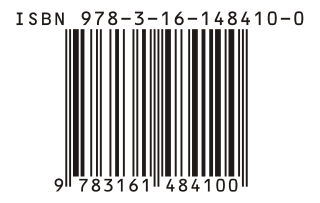
Nagykörút or Grand Boulevard is one of the most central and busiest parts of Budapest, a major thoroughfare built by 1896, Hungary's Millennium. It forms a semicircle connecting two bridges of the Danube, Margaret Bridge on the north and Petőfi Bridge on the south. Usually the part inside and around this semicircle is counted as the city centre of Budapest.

Kiskörút or Small Boulevard is a major thoroughfare in Budapest. It forms an incomplete semicircle between Deák Square and Fővám Square. It is the border of the southern part of District 5, the innermost district of Pest. As opposed to Nagykörút, it only touches the Danube at its southern end.

Kálvin tér is a major square and intersection in the city center of Budapest, the capital of Hungary. It was named after the French Protestant Reformer John Calvin due to the large Reformed Church located there.
Ferenciek tere is a square and junction in Budapest. In addition to being the site of a station on the M3 (North-South) line of the Budapest Metro, it is an important public transport junction for the BKV bus line number 7, which connects Pest and southern Buda.

Lehel tér is a station on the Budapest Metro Line 3 (North-South). It is located beneath the eponymous square Lehel tér, named after the Hungarian chieftain Lehel.

Széll Kálmán tér is a square in Budapest. It is one of the city's busiest transport interchanges, which is served by a station on Metro line 2, tram lines 4, 6, 17, 56, 56A, 59, 59A, 59B, 61 and bus lines 5, 16, 16A, 21, 21A, 22, 22A, 39, 91, 102, 116, 128, 129, 139, 140, 140A, 142, 149, 155, 156, 222.

Budapest Keleti (eastern) railway station is the main international and inter-city railway terminal in Budapest, Hungary.
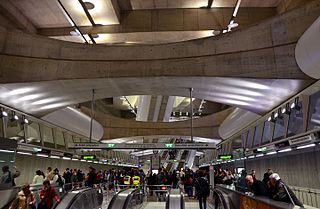
Kálvin tér is a transfer station on the M3 and the M4 lines of the Budapest Metro. It is located beneath the eponymous square, named after John Calvin.
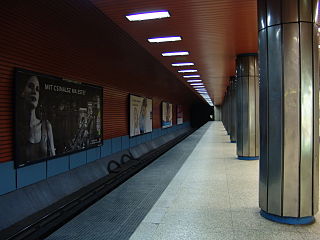
Ferenciek tere is a station on the M3 (North-South) line of the Budapest Metro located under the eponymous square in the Downtown. It is an important junction, as several bus lines from Buda pass through or terminate here. It is also the station closest to the geographical city centre of Budapest. The station's name was Felszabadulás tér before 1990.

Deák Ferenc tér is a transfer station on the M1, M2, and M3 lines of the Budapest Metro. It is located under the eponymous city square in central Budapest, the capital city of Hungary. Owing to its direct transfer connection between three out of the four metro lines Budapest has and its downtown location, it is one of the busiest stations in the system.

Széll Kálmán tér is a station on the M2 (East-West) line of the Budapest Metro. It is located under Széll Kálmán Square in Buda. At 38.4m below ground level, it is the deepest station of the Budapest Metro. Near the station, numerous bus and tram routes pass or converge, making it one of the city's major transport interchanges.

Kossuth Lajos tér is a station on the M2 (East-West) line of the Budapest Metro. It is located south of Lajos Kossuth Square in Pest, immediately on the left bank of the Danube river.

Haller utca is a main street along the border of Mid-Ferencváros, in the 9th district of Budapest, Hungary. It links Nagyvárad tér in the north and Soroksári út in the west. Notable sidestreets include Tűzoltó utca, Balázs Béla utca, Gát utca, Mester utca and Vaskapu utca. The street is named after the Haller family, who were Bavarian origin principal nobles in the early modern Hungary. According to some reviews the street is named after János Haller (1626–1697), who was a prominent figure of the family.
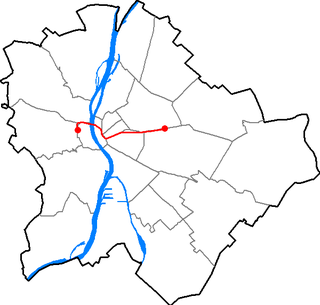
Line 2 is the second line of the Budapest Metro. The line runs east from Déli pályaudvar in north-central Buda under the Danube to the city center, from where it continues east following the route of Rákóczi út to its terminus at Örs vezér tere.
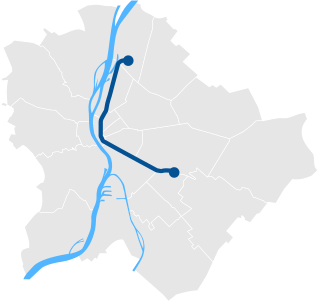
Line 3 is the third and longest line of the Budapest Metro. It runs in a general north-south direction parallel to the Danube on the Pest side, roughly following Váci út south from Újpest to the city center, then following the route of Üllői út southeast to Kőbánya-Kispest. Its daily ridership is estimated at 626,179. Like Line 1, it does not serve Buda.
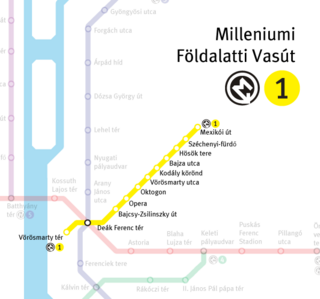
Line 1 is the oldest line of the Budapest Metro. It is known locally as "the small underground", while the M2, M3 and M4 are called "metró". It is the third oldest underground after the London Underground and the Mersey Railway, the third rapid transit rail line worldwide of any type to exclusively use electric traction, and the first on the European mainland. It was built from 1894 to 1896.

Szent Gellért tér – Műegyetem(formerly Szent Gellért tér) is a station of Line 4 of the Budapest Metro. It is located beneath the eponymous square, named after Szent Gellért, patron saint of Budapest, and was opened in March 2014. Artist Tamás Komoróczky was commissioned to design the mosaic interior decoration of the inner platform below the University of Technology and Economics. It is the deepest station on Line 4.

Route 200E(or Airport bus) is a bus route in Budapest. The line currently runs between the Budapest Ferenc Liszt International Airport and Nagyvárad tér metro station. The route is served by BKK and operated by BKV Zrt.



















